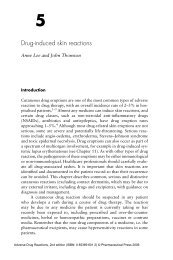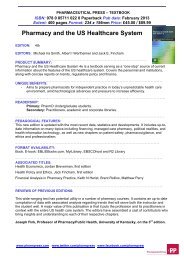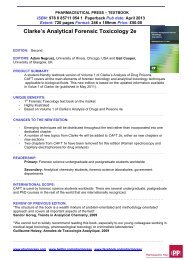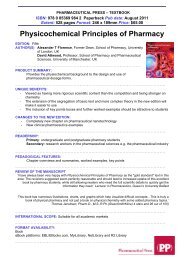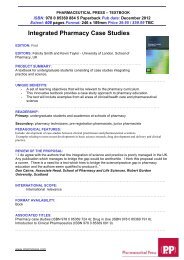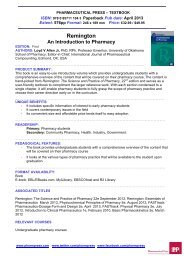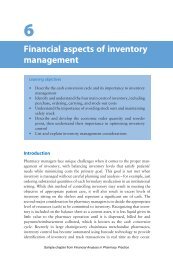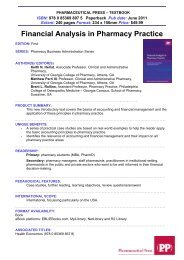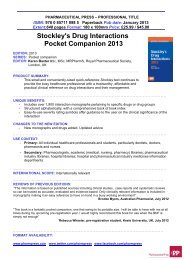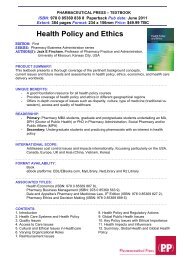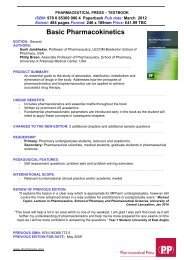6 Extravascular routes of drug administration
6 Extravascular routes of drug administration
6 Extravascular routes of drug administration
You also want an ePaper? Increase the reach of your titles
YUMPU automatically turns print PDFs into web optimized ePapers that Google loves.
116 Basic Pharmacokinetics<br />
• incomplete wetting <strong>of</strong> <strong>drug</strong> particles (large contact<br />
angle may result in a smaller effective<br />
surface area) owing to the hydrophobic nature<br />
<strong>of</strong> the <strong>drug</strong> or the agglomeration <strong>of</strong> smaller insoluble<br />
<strong>drug</strong> particles<br />
• poor formulation, affecting any <strong>of</strong> the above<br />
• a delayed release formulation.<br />
Negative lag time (−t0)<br />
Figure 6.13 shows a plot with an apparent negative<br />
lag time.<br />
What does negative lag time mean? Does it mean<br />
that absorption has begun prior to the <strong>administration</strong><br />
<strong>of</strong> a <strong>drug</strong>? That cannot be possible unless the<br />
body is producing the <strong>drug</strong>! The presence <strong>of</strong> a negative<br />
lag time may be attributed to a paucity <strong>of</strong> data<br />
points in the absorption as well as in the elimination<br />
phase.<br />
The absorption rate constant obtained by the<br />
feathering, or residual, method could be erroneous<br />
under the conditions stated above. Should that be the<br />
case, it is advisable to employ some other methods<br />
(Wagner–Nelson method, statistical moment analysis,<br />
Loo–Rigelman method for a two-compartment<br />
model, to mention just a few) <strong>of</strong> determining the<br />
absorption rate constant. Though these methods tend<br />
to be highly mathematical and rather complex, they<br />
do provide an accurate estimate <strong>of</strong> the absorption rate<br />
constant, which, in turn, permits accurate estimation<br />
<strong>of</strong> other pharmacokinetic parameters such as peak<br />
time and peak plasma concentration, as well as the<br />
assessment <strong>of</strong> bioequivalence and comparative and/or<br />
relative bioavailability.<br />
6.7 Some important comments on<br />
the absorption rate constant<br />
Figure 6.14 indicates that the greater the difference<br />
between the absorption and the elimination rate constants<br />
(i.e., Ka ≫ K), the faster is <strong>drug</strong> absorption and<br />
the quicker is the onset <strong>of</strong> action (in Fig. 6.14, apply<br />
the definition <strong>of</strong> onset <strong>of</strong> action). Note the shift in the<br />
peak time and peak plasma concentration values as<br />
the difference between absorption rate constant (Ka)<br />
and elimination rate constant (K) becomes smaller, as<br />
you go from left to right <strong>of</strong> the figure. If the absorption<br />
rate constant (Ka) is equal to the elimination rate<br />
C p (mg L –1 )<br />
(–t 0 )<br />
Intercept <strong>of</strong><br />
feathered and<br />
extrapolated lines<br />
Time (h)<br />
Feathered line<br />
Figure 6.13 Semilogarithmic plot <strong>of</strong> plasma concentration<br />
(Cp) versus time showing a negative value for the lag time (t0).<br />
constant (K), we need to employ a different pharmacokinetic<br />
model to fit the data.<br />
Note that the absorption rate constant for a given<br />
<strong>drug</strong> can change as a result <strong>of</strong> changing the formulation,<br />
the dosage form (tablet, suspension, capsule) or<br />
the extravascular route <strong>of</strong> <strong>drug</strong> <strong>administration</strong> (oral,<br />
intramuscular, subcutaneous, etc.). Administration <strong>of</strong><br />
a <strong>drug</strong> with or without food will also influence the<br />
absorption rate constant for the same <strong>drug</strong> administered<br />
orally through the same formulation <strong>of</strong> the same<br />
dosage form.<br />
6.8 The apparent volume <strong>of</strong><br />
distribution (V)<br />
Sample chapter for Basic Pharmacokinetics 2nd edition<br />
For a <strong>drug</strong> administered by the oral route, or any<br />
other extravascular route <strong>of</strong> <strong>administration</strong>, the apparent<br />
volume <strong>of</strong> distribution cannot be calculated<br />
from plasma <strong>drug</strong> concentration data alone. The reason<br />
is that the value <strong>of</strong> F (the fraction <strong>of</strong> administered<br />
dose that reaches the general circulation) is not<br />
known. From Eqs. (6.6)–(6.8):<br />
Intercept = KaFX0<br />
. (6.26)<br />
V(Ka − K)<br />
If we can reasonably assume, or if it has been<br />
reported in the scientific literature, that F = 1.0 (i.e.,<br />
the entire administered dose has reached the general<br />
circulation), only then can we calculate the apparent<br />
volume <strong>of</strong> distribution following the <strong>administration</strong><br />
<strong>of</strong> a <strong>drug</strong> by the oral or any other extravascular<br />
route.



